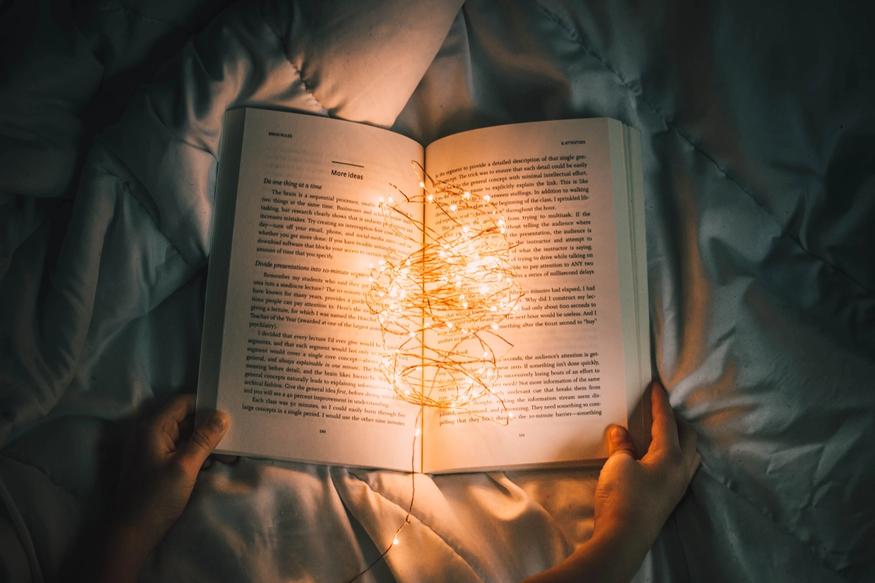7 Steps to Double the Number of Books You Read This Year
Published on 9/18/2020In 2019 I read ten books, and I’m already on twenty-five books for 2020.
During my childhood, I was rarely found with my nose out of a book. I can thank my father for this. He had always been an avid reader, and so he fuelled this in me by reading to me from a young age and never passing a bookshop without stopping. He used to travel for work a lot, and he would bring me back a book each time. I got chickenpox when I was about eleven years old, and I remember loving it because I could just stay home and read books.
But at some point, I lost that drive to read. I still loved books; I read blurbs and bought numerous. But they stayed on my bedside table or bookshelf, waiting for when I ‘would have time’. I went from easily consuming a book a week to not even managing one per month. Being a reader had always been a core part of my identity, especially given my love for writing. You would see it time and time again, the primary tip given to writers was to read more. How could I hope to become a better writer without reading more of what is good? I think a part of me also wanted to reconnect with my father through it, use this shared passion to power through my grief.
So I made a change. I did my research, not only online but by speaking to avid readers to find out what works for them. I began to prioritise reading, to give it a firm place in my life. I stand by the following seven steps to reading more, as they have led me to read 25 books so far in 2020. And it is only September, I’m hoping for 35 by the end of this year, which will be over triple what I read last year.

1. Goodreads
First, let’s start with how I know exactly how many I’ve read, as it took me mere minutes to check. I use Goodreads, which was described to me as a social network for book readers. It is entirely free, you just make an account, and you can link it to your other social profiles if you want, or keep it separate. Then you can browse books through it, save books you want to read later, and input what you are currently reading. When you finish a book, you can write a review or even just give it a score out of 5. All of your ‘friends’ can see what you’re reading or intend to read. It also recommends books based on what you liked.
I love using Goodreads for several reasons. Firstly, it allows me to track my reading easily. I can look back at what I’ve read, the scores or note I wrote for it, and how long it took me to read. This is super handy and helps me to recommend books to friends. Secondly, it is a great place to find new things to read, in case you’re struggling with inspiration. Both by the books it recommends for you and seeing what other people that you know are reading. Furthermore, you can set yourself a reading challenge on the website. So I said that I wanted to read 35 books this year, and it shows me how far along I am on this challenge, whether I am behind, or ahead one book like I am now. This motivates me to keep reading and achieve my goal, especially as people following can see my challenge and progress.
If you don’t want to use Goodreads, you could always set up an easy spreadsheet instead! I think the most important aspect is writing a short review for each book. Just to sum up what you’ve learned or liked in the book, to keep it fresher in your memory or use in your own writing.
2. Choosing books
This is the most prominent mistake people make when trying to read more. I am guilty of it too. Most of us want to dive right in. We have a list of “must-read” classics that are sitting on our shelf impatiently. So after barely reading more than an Instagram post in months, we start with Jane Eyre. This like not working out properly for months and then signing up for a half-marathon. Reading is a muscle that must be warmed up properly and eased back into exercise. Don’t push yourself into the deepest part of the pool and set yourself up for failure.
My biggest advice for people who want to read more is to start with your guilty pleasures. Whether this is vampire romance, fantasy novels, young adult books or memoirs. Whatever genre you struggle the most to put down is how you should start. You can reread an old favourite or try a book you know you’ll love. Just make it easier and break into your new reading habit with something you love. And if that is classic dense novels, then fine, read those!
This isn’t to say that you’ll never read the more challenging books. Once you’re a few books back in and devouring words once more, throw in one of your bucket list books. I find reading non-fiction more difficult than fiction, so I aim to read one non-fiction book after two fiction. Because I do want to learn more and enjoy these books, I know that fiction is where my true love for reading lies.
I got my good reading mojo back on with Percy Jackson books. I almost feel embarrassed when saying it, as they are young adult books about demi-gods fighting evil. But Rick Riordan is a talented author and keeps me hooked on every page. I devoured the series, never taking longer than a week to finish one. And I learned from them as a writer. But most importantly, I enjoyed reading them. I felt like my younger self, fighting sleepy eyelids and unable to put the book down.
Reading is also for pleasure. Don’t forget that, lean into even. Start with books you enjoy most and build it up from there. You’ll find your numbers soaring after that.
3. Don’t read faster, read better
I disagree with reading for the sake of reading. That might sound hypocritical given this article. But I don’t want to read more just to say a bigger number. I want to read more as I love reading, learn from it and it calms me. Having a goal number pushes me to do it and gain these benefits. There are a lot of our tips out there about listening to books on audio, increasing the speed, or sight-reading to get through them faster. I won’t advise you on that as I’m writing from experience.
But I will say that reading more is also about reading better. It’s about staying focused, rereading the page if you realise you skimmed it. Put the book down and then remind yourself of what just happened or what you learned. Like I mentioned previously, write a few sentences about the book once you’ve finished. What was it about? And what did you think of it? Even if you are not a writer, there is something to be learned from every book.
Reading purposefully and actively will save you time on books in the long run, as you’re focused and not drifting off. You are treating it like an activity and not a chance to multitask.
4. Sharing is caring
I don’t just mean sharing your books, even though you should definitely swap books with friends to be able to read more on a budget. I mean share tips with each other. Friends have leant me books that I never had heard of or considered, and I am so thankful for the great read. That young adult series I am obsessed with? My boyfriend forced me to read them and gave me his childhood collection. And now the Percy Jackson series is within my top favourite books, and I am becoming a better writer from them. Start discussing books with your friends! Bring them into your conversations, text each other recommendations.
I also recommend a book club. During COVID-19, I started one with two friends using Zoom, and it was great! I read the book more purposefully, taking notes and genuinely considering the text. I had my opinions challenged by others and was led to reconsider how I viewed characters. I got to debate about fictional characters as if they were real friends. It was such a fun social activity, especially during this stressful time, and helped me to read more. I cannot recommend a book club enough, and I have an article of tips if you’d like to try your own.
5. Monogamy not required
This was the biggest change for me to learn. I have always been a one book girl, no messing around on the side. I take the commitment seriously; when I start something, I have to finish it. And while I’m still focused on finishing, I do allow myself a slice on the side.
You can read more than one book at a time. I usually have a fiction book I am reading wholeheartedly, and then a non-fiction book I am working through. I don’t like to read non-fiction right before bed, as I don’t feel like it’s beneficial then. I usually bring my non-fiction book to read on a train or before an appointment, or just at home when I want to be productive but can’t write anymore. This also applies to when you’re doing a book club, as you have set chapters per week so aside from those you can be reading something else. Having a book on the side is preferable to cheating on your book club chapters and reading ahead.
Don’t be afraid to have different books for different moments. And you can also consider how committed you are to finishing books if you’re not enjoying them.
6. Find the moment
You have time to read.
Let me say that again. You have time to read. Telling yourself or other people otherwise is a lie. Whenever I feel overwhelmed or stressed about the numbers of tasks I have, I remind myself that I have enough time in the day, I just need to find it. And it’s true. Out of the approximately 16 hours that we are awake, there is definitely a half an hour window for you to read. Reading half an hour a day can have you finishing a book within two weeks easily. You need to find that window.
I keep a book on my bedside table, and every evening I read for about fifteen to twenty minutes. This is a rule. Even if I’m tired or a bit tipsy, I will read. It’s a great way to get off my phone in bed, calm myself for sleep and fit in reading time. I love this habit. I introduced it almost a year ago, and it is the best thing I have done for myself.
But it doesn’t have to be that time slot, find what works for you. Maybe you like reading as soon as you wake up, before getting out of bed to meet the world. Perhaps you like reading in the afternoon, or after you finish working as a break before cooking. Find your time slot, multiple if you like, but stick to it. Make it a rule, a must. That might sound counterintuitive to enjoying reading, but it is just about habit formation. We need a push to do the thing that is good for us, even if we enjoy it, as it doesn’t feel as comfortable as the addictiveness of being on your phone or Netflix.
7. Always carry a book
This is something I learned from my sister, Daphne, who wrote an article on how she read 100 books in a year. Yeah, I left that till last to make my measly 25 seem impressive. But if you read her piece, you’ll see that we have different priorities and focuses when it comes to reading.
Always carry a book. This is easier when you have an e-reader, but still possible without one. Have the Kindle app on your phone even, to snatch stolen moments. As I mentioned, I slowly plough through a non-fiction book alongside my fiction sweetheart, and I’ll keep this in my bag. Whenever I’m on public transport or waiting somewhere, I fight the urge to scroll through my phone mindlessly, and instead, I steal a few pages. It might not sound effective, but over time you can read a lot of books that way. You never realise how much time you’re on your phone doing nothing, and taking even two pages of your book each time is undoubtedly preferable. It’s hard, but a worthwhile habit to build. And less blue light and Instagram tapping is another bonus.

These seven steps are not crazy or over-aspirational. They are simple tweaks to your existing routine. More than that, they are placing a priority on reading in your mind. You need to want to read more, and then you need to make it happen. Follow these seven steps, and doubling the amount you read last year will be easy.
1. Track the books you read
2. Choose books you actually want to read
3. Read with purpose
4. Talk about books with others
5. Read more than one book at a time
6. Set a daily moment to read
7. Always carry a book
There are going to be times when you read more, such as on a beach holiday, and times that you read less, such as a busy period at work or if you’re really unwell. That’s okay; they make up for each other. At the end of the day, it isn’t about reaching a high number or proving something. It is about whether you want to read more, and doing it if the answer is yes. Shaping the life you wish to live in today, not tomorrow. Stop saying you’ll read more, and either do it or realise that you don’t actually want to. It isn’t easy, but there are easy steps you can take towards it. Everything comes down to that decision, that question that you need to ask yourself:
Do I want to read more?
Please be aware that this article contains affiliate links.
Featured posts

Fleur
Welcome to Symptoms of Living! A place where I like to relieve myself of the barrage of thoughts and ideas filling my mind. Here I'll take a look at various topics, from books to BPD, series to self-harm, there's nothing that we can't, and shouldn't, talk about.
Having struggled with mental illness since the age of 15, one of the hardest parts was how alone I felt in it. While mental illness is beginning to be discussed more openly, and featured in the media, I still think there is room for improvement. So whether it is mental illness or merely mental health, a bad day or a bad year, let's make this a place to approach it and strip it back. Everyone has their own symptoms of living, and you certainly won't be the only one with it.
Would you like to receive my top monthly articles right to your inbox?
For any comments/questions/enquiries, please get in touch at:
info@byfleurine.com
I'd love to hear from you!